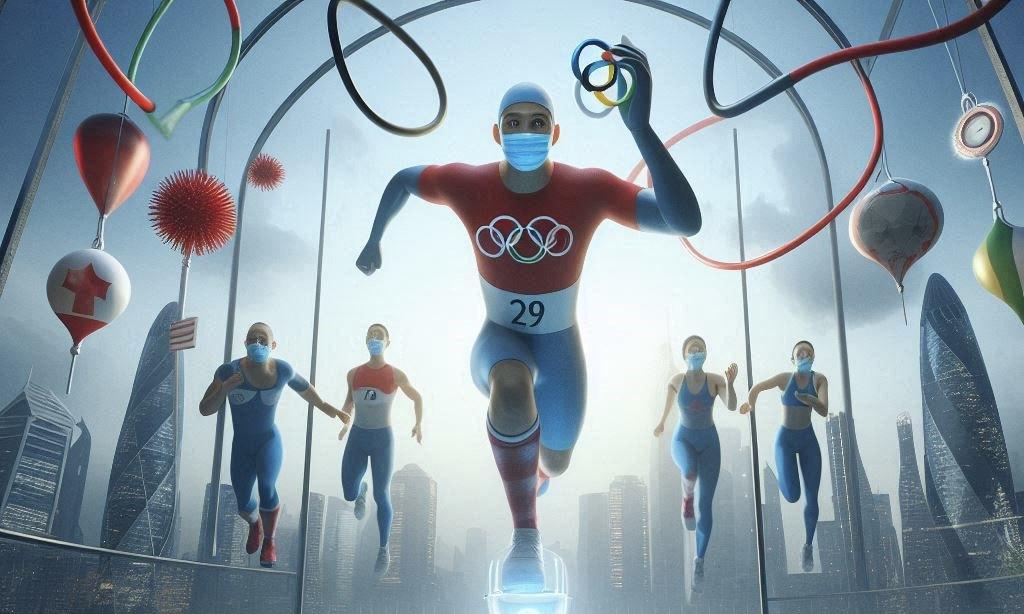As the world emerges from the shadow of a global pandemic, the upcoming Olympic Games have taken on a new dimension, focusing heavily on health and safety measures that were once peripheral. With the global health landscape still facing challenges, the Games have become a platform not only for athletic excellence but also for demonstrating how international events can adapt to ensure the well-being of participants.
The current state of global health has necessitated an unparalleled emphasis on safeguarding the physical health of everyone involved in the Olympics. Organizers have meticulously crafted protocols designed to minimize the risk of infection and ensure that the Games proceed without incident. These measures range from advanced screening procedures to rigorous daily testing for athletes, coaches, and support staff. The Olympic Village, once known for its camaraderie and bustling social environment, has been transformed into a highly controlled zone where interactions are carefully monitored to prevent any potential outbreak.
Physical distancing measures are strictly enforced, with adjustments made to accommodate the unique demands of hosting a global event in the post-pandemic era. Athletes are required to maintain separation not just in competition but also during their daily routines within the Village. Dining areas, for instance, have been reconfigured to ensure that athletes can eat in a safe environment, with barriers in place and staggered meal times to avoid crowding.
The health of athletes extends beyond the immediate threat of viral infection. Recognizing the mental strain imposed by both the pandemic and the intense pressure of competing on the world stage, organizers have implemented a comprehensive suite of support services. Mental health professionals are on hand to assist athletes, offering counseling and other resources aimed at mitigating the psychological toll of competing in such an environment. The introduction of these services marks a significant shift in the approach to athlete welfare, acknowledging that mental health is as critical as physical health in ensuring peak performance.
In the arena of public health, the Olympics have also become a testing ground for new technologies and practices. The use of contactless technology has been expanded, from entry checkpoints to payment systems within venues, reducing the need for physical contact and enhancing safety. Additionally, there is a heightened focus on sanitation, with frequent cleaning schedules and the availability of hand sanitizers at every turn, ensuring that athletes and staff can maintain high levels of hygiene.
The Olympic Committee's strategy also includes contingency plans for handling any potential cases of COVID-19, with isolation facilities ready to be activated if needed. These measures are part of a broader effort to reassure both athletes and the international community that every precaution has been taken to protect health and safety.
While the Games have always been a symbol of international unity and competition, this year they also represent resilience and adaptability. The rigorous health and safety protocols, combined with a renewed emphasis on athlete welfare, highlight the changing nature of global sports events in a post-pandemic world. As the Olympics approach, these measures are likely to set a precedent for how large-scale events can be conducted in an era where health concerns remain a global priority.



 Oil Prices Slip as Russia-Ukraine Peace Hopes Fade and Oversupply Fears Grow
Oil Prices Slip as Russia-Ukraine Peace Hopes Fade and Oversupply Fears Grow  Pfizer Boosts Bid for Metsera Amid Intensifying Rivalry with Novo Nordisk in Obesity Drug Market
Pfizer Boosts Bid for Metsera Amid Intensifying Rivalry with Novo Nordisk in Obesity Drug Market  Trump's Transgender Sports Ban Faces Enforcement Challenges
Trump's Transgender Sports Ban Faces Enforcement Challenges  Australia’s major sports codes are considered not-for-profits – is it time for them to pay up?
Australia’s major sports codes are considered not-for-profits – is it time for them to pay up?  U.S. May Withhold $30.4 Million From Minnesota Over Improper Commercial Driver Licenses
U.S. May Withhold $30.4 Million From Minnesota Over Improper Commercial Driver Licenses  Apple Eyes U.S. Formula 1 Broadcast Rights in Major Sports Streaming Push
Apple Eyes U.S. Formula 1 Broadcast Rights in Major Sports Streaming Push  Champions League final 2025: a battle for glory against a backdrop of money and fashion
Champions League final 2025: a battle for glory against a backdrop of money and fashion  Innovent’s Xinermei Intensifies Weight-Loss Drug Battle in China
Innovent’s Xinermei Intensifies Weight-Loss Drug Battle in China  Native American Groups Slam Trump’s Call to Restore Redskins Name
Native American Groups Slam Trump’s Call to Restore Redskins Name  Trump Hints at Major Autism Announcement, Raises Questions on Tylenol Link
Trump Hints at Major Autism Announcement, Raises Questions on Tylenol Link  Oil Prices Rise as Ukraine Targets Russian Energy Infrastructure
Oil Prices Rise as Ukraine Targets Russian Energy Infrastructure  Trump Signs Executive Order Targeting Big-Money College Athlete Payouts
Trump Signs Executive Order Targeting Big-Money College Athlete Payouts  US Reviewing Visa Denial for Venezuelan Little League Team Barred from World Series
US Reviewing Visa Denial for Venezuelan Little League Team Barred from World Series  China Urged to Prioritize Economy Over Territorial Ambitions, Says Taiwan’s President Lai
China Urged to Prioritize Economy Over Territorial Ambitions, Says Taiwan’s President Lai  Major Drugmakers Slash U.S. Prices and Sell Directly to Patients Amid Trump’s Push for Affordable Medicines
Major Drugmakers Slash U.S. Prices and Sell Directly to Patients Amid Trump’s Push for Affordable Medicines  Extreme heat, flooding, wildfires – Colorado’s formerly incarcerated people on the hazards they faced behind bars
Extreme heat, flooding, wildfires – Colorado’s formerly incarcerated people on the hazards they faced behind bars 





























